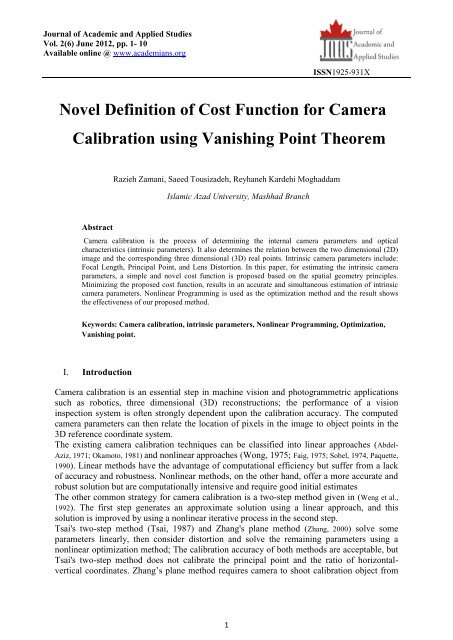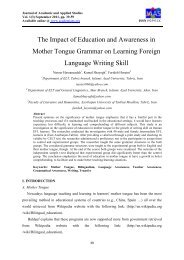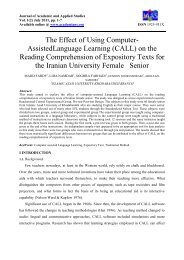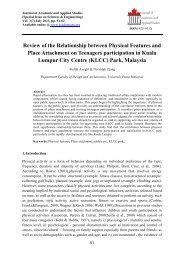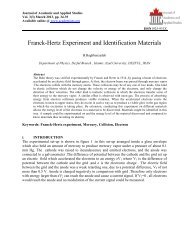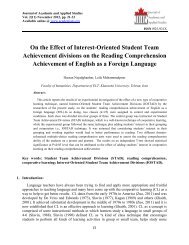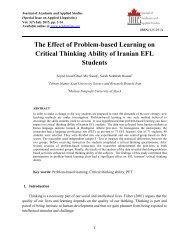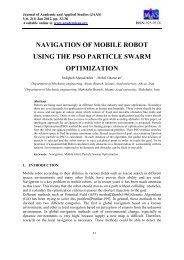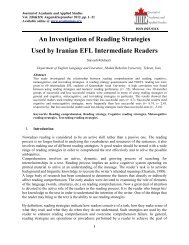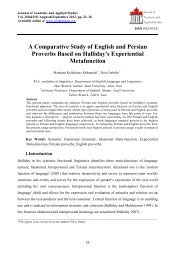Novel Definition of Cost Function for Camera Calibration using ...
Novel Definition of Cost Function for Camera Calibration using ...
Novel Definition of Cost Function for Camera Calibration using ...
You also want an ePaper? Increase the reach of your titles
YUMPU automatically turns print PDFs into web optimized ePapers that Google loves.
Journal <strong>of</strong> Academic and Applied Studies<br />
Vol. 2(6) June 2012, pp. 1- 10<br />
Available online @ www.academians.org<br />
ISSN1925-931X<br />
<strong>Novel</strong> <strong>Definition</strong> <strong>of</strong> <strong>Cost</strong> <strong>Function</strong> <strong>for</strong> <strong>Camera</strong><br />
<strong>Calibration</strong> <strong>using</strong> Vanishing Point Theorem<br />
Razieh Zamani, Saeed Tousizadeh, Reyhaneh Kardehi Moghaddam<br />
Islamic Azad University, Mashhad Branch<br />
Abstract<br />
<strong>Camera</strong> calibration is the process <strong>of</strong> determining the internal camera parameters and optical<br />
characteristics (intrinsic parameters). It also determines the relation between the two dimensional (2D)<br />
image and the corresponding three dimensional (3D) real points. Intrinsic camera parameters include:<br />
Focal Length, Principal Point, and Lens Distortion. In this paper, <strong>for</strong> estimating the intrinsic camera<br />
parameters, a simple and novel cost function is proposed based on the spatial geometry principles.<br />
Minimizing the proposed cost function, results in an accurate and simultaneous estimation <strong>of</strong> intrinsic<br />
camera parameters. Nonlinear Programming is used as the optimization method and the result shows<br />
the effectiveness <strong>of</strong> our proposed method.<br />
Keywords: <strong>Camera</strong> calibration, intrinsic parameters, Nonlinear Programming, Optimization,<br />
Vanishing point.<br />
I. Introduction<br />
<strong>Camera</strong> calibration is an essential step in machine vision and photogrammetric applications<br />
such as robotics, three dimensional (3D) reconstructions; the per<strong>for</strong>mance <strong>of</strong> a vision<br />
inspection system is <strong>of</strong>ten strongly dependent upon the calibration accuracy. The computed<br />
camera parameters can then relate the location <strong>of</strong> pixels in the image to object points in the<br />
3D reference coordinate system.<br />
The existing camera calibration techniques can be classified into linear approaches (Abdel-<br />
Aziz, 1971; Okamoto, 1981) and nonlinear approaches (Wong, 1975; Faig, 1975; Sobel, 1974, Paquette,<br />
1990). Linear methods have the advantage <strong>of</strong> computational efficiency but suffer from a lack<br />
<strong>of</strong> accuracy and robustness. Nonlinear methods, on the other hand, <strong>of</strong>fer a more accurate and<br />
robust solution but are computationally intensive and require good initial estimates<br />
The other common strategy <strong>for</strong> camera calibration is a two-step method given in (Weng et al.,<br />
1992). The first step generates an approximate solution <strong>using</strong> a linear approach, and this<br />
solution is improved by <strong>using</strong> a nonlinear iterative process in the second step.<br />
Tsai's two-step method (Tsai, 1987) and Zhang's plane method (Zhang, 2000) solve some<br />
parameters linearly, then consider distortion and solve the remaining parameters <strong>using</strong> a<br />
nonlinear optimization method; The calibration accuracy <strong>of</strong> both methods are acceptable, but<br />
Tsai's two-step method does not calibrate the principal point and the ratio <strong>of</strong> horizontalvertical<br />
coordinates. Zhang’s plane method requires camera to shoot calibration object from<br />
1
Journal <strong>of</strong> Academic and Applied Studies<br />
Vol. 2(6) June 2012, pp. 1- 10<br />
Available online @ www.academians.org<br />
ISSN1925-931X<br />
various angles. Reference (Wei xing and Feng, 2006) proposes a linear calibration method basing<br />
on coplanar, but the method ignores the lens distortion and the calibration accuracy is low.<br />
The first step utilizing linear approaches is a key to the success <strong>of</strong> two-step methods.<br />
Approximate solutions provided by the linear techniques must be good enough <strong>for</strong> the<br />
subsequent nonlinear techniques to correctly converge. Being susceptible to noise in image<br />
coordinates, the existing linear techniques are, however, notorious <strong>for</strong> their lack <strong>of</strong> robustness<br />
and accuracy (Wang and Xu, 1996). In ref (Haralick et al., 1989) shows that when the noise level<br />
exceeds a knee level or the number <strong>of</strong> points is below a knee level, these methods become<br />
extremely unstable and the errors diverge.<br />
The use <strong>of</strong> more points can help alleviate this problem. However, fabrication <strong>of</strong> more control<br />
points <strong>of</strong>ten proves to be difficult, expensive, and time-consuming. For applications with a<br />
limited number <strong>of</strong> control points, e.g., close to the required minimum number, it is<br />
questionable whether linear methods can consistently and robustly provide well enough<br />
initial guesses <strong>for</strong> the subsequent nonlinear procedure to correctly converge to the optimal<br />
solution. Another problem is that almost all nonlinear techniques employed in the second step<br />
use variants <strong>of</strong> conventional optimization techniques. They there<strong>for</strong>e all inherit well known<br />
problems plaguing these conventional optimization methods, namely, poor convergence and<br />
susceptibility to getting trapped in local extremum. If the starting point <strong>of</strong> the algorithm is not<br />
well chosen, the solution can diverge, or get trapped at a local minimum. This is especially<br />
true if the objective function landscape contains isolated valleys or broken ergodicity.<br />
In this paper we introduced a cost function based on the spatial geometry principles. In this<br />
method Nonlinear Programming is used as the optimization tool. The innovation <strong>of</strong> the<br />
proposed method is the estimation simultaneity <strong>of</strong> all intrinsic camera parameters <strong>using</strong> the<br />
cost function that includes all intrinsic camera parameters and normalized projected points <strong>of</strong><br />
the real world. Result shows an accurate and feasible estimation <strong>of</strong> intrinsic camera<br />
parameters.<br />
II.<br />
Nonlinear Programming<br />
Nonlinear programming (NLP) is the process <strong>of</strong> determining unknown parameters <strong>of</strong> system<br />
<strong>for</strong> minimizing an objective function subject to nonlinear system equations and some equal or<br />
non equal conditions. The NLP problems have the common following <strong>for</strong>m:<br />
min f(x)<br />
xεX<br />
s. t. g(x) ≤ 0<br />
X ⊆ R n<br />
where X is a subset <strong>of</strong> R n x , and f : x → R, g: X → R n g<br />
and f is the objective<br />
function.g i (x) ≤ 0, i = 1,..., n g , are inequality constraints, and i (x) = 0, i = 1,……., n ,are<br />
constraints. Note also that the set X typically includes lower and upper bounds on the<br />
variables; the reason <strong>for</strong> separating variable bounds from the other inequality constraints is<br />
that they can play a useful role in some algorithms, i.e., they are handled in a specific way.<br />
2
Journal <strong>of</strong> Academic and Applied Studies<br />
Vol. 2(6) June 2012, pp. 1- 10<br />
Available online @ www.academians.org<br />
ISSN1925-931X<br />
Easily we can say that the NLP is the problem <strong>of</strong> finding a feasible point x ∗ such that f(x) ≥<br />
f(x ∗ ) where x ∗ is a feasible solution, which satisfies all constraints. <strong>for</strong> each feasible point x<br />
needless to say, a NLP problem can be stated as a minimization problem, and the inequality<br />
constraints can be written in the <strong>for</strong>m can be written in the <strong>for</strong>m g(x) ≥ 0.<br />
III.<br />
<strong>Camera</strong> Model<br />
Earlier camera calibration techniques usually employed a perfect pinhole camera model.<br />
p w : A point in a three-dimensional (3D) space in front <strong>of</strong> the camera.<br />
P w =<br />
P wx<br />
P wy<br />
P wz<br />
(1)<br />
p c : Coordinates <strong>of</strong> p w in camera system coordinates.<br />
P c =<br />
P cx<br />
P cy<br />
P cz<br />
(2)<br />
x ∗ ,y ∗ are the coordinates <strong>of</strong> the principal point in the<br />
Image plane:<br />
x ∗<br />
y ∗ =<br />
f<br />
P cz<br />
P cx<br />
P cy<br />
(3)<br />
The relation between the real world coordinate (3D coordinate) and camera system<br />
coordinate is as follows:<br />
Where<br />
e : canonical center coordinate<br />
M cw : <strong>Camera</strong> orientation<br />
P w =M cw P C + e , M cw =<br />
u 1 v 1 w 1<br />
u 2 v 2 w 2 (4)<br />
u 3 v 3 w 3<br />
P C =M wc (P w - e) , M cw T = M wc (5)<br />
IV.<br />
Marker projection on the Image Plane Procedure<br />
We assume m is a point in the camera system coordinate<br />
3
Journal <strong>of</strong> Academic and Applied Studies<br />
Vol. 2(6) June 2012, pp. 1- 10<br />
Available online @ www.academians.org<br />
ISSN1925-931X<br />
x m<br />
x m<br />
x m<br />
(6)<br />
n is the normalized coordinates <strong>of</strong> m based on pinhole camera model<br />
x n<br />
y n<br />
=<br />
x m zm<br />
y m zm<br />
(7)<br />
r is defined as follows:<br />
By applying lens distortion model to n,<br />
d is obtained.<br />
r 2 = x n<br />
2<br />
+ y n<br />
2<br />
(8)<br />
x d<br />
y d<br />
= (1 + k 1 r 2 + k 2 r 4 ) x n<br />
y n<br />
(9)<br />
After applying lens distortion model by applying camera model matrix, the final pixel position<br />
related to the projection <strong>of</strong> m in camera image plane, calculated as follows:<br />
x p<br />
y p<br />
1<br />
=<br />
f x αf x x R<br />
0 f y y R<br />
0 0 1<br />
x d<br />
y d<br />
1<br />
(10)<br />
The above square matrix (K) is called <strong>Calibration</strong> Matrix.<br />
The constraints are obtained from equations (11) and (12).<br />
f x .x n . (1+k 1 .r 2 +k 2 .r 4 ) + x R -x p =0 (11)<br />
f y .y n . (1+k 1 .r 2 +k 2 .r 4 ) + y R -y p =0 (12)<br />
V. Objective <strong>Function</strong><br />
Earlier than introducing the objective function it is necessary to explain the concept <strong>of</strong> vanishing<br />
point comprehensibly.<br />
A. Vanishing point <strong>of</strong> a line<br />
4
Journal <strong>of</strong> Academic and Applied Studies<br />
Vol. 2(6) June 2012, pp. 1- 10<br />
Available online @ www.academians.org<br />
ISSN1925-931X<br />
The vanishing point <strong>of</strong> a line is a point on the image plane that is obtained by intersecting the image<br />
plane with a ray parallel to the world line and passing through the camera centre.<br />
The perspective geometry that gives rise to vanishing points is illustrated in Figure 1. In this figure,<br />
the point C is the camera centre and plane S is the image plane. Vector d is a vector with direction<br />
<strong>of</strong> the line D. The vanishing point, v, <strong>of</strong> the line D with direction d, is the intersection <strong>of</strong> the image<br />
plane (plane S) with a ray parallel to d through C (camera centre). Thus a vanishing point <strong>of</strong> a line<br />
depends only on the direction <strong>of</strong> the line, not on its position. Consequently a set <strong>of</strong> parallel lines<br />
have a unique vanishing point, as illustrated in Figure 1. For example image <strong>of</strong> infinite railway<br />
lines, are converging lines, and their image intersection is the vanishing point <strong>for</strong> the direction <strong>of</strong><br />
the railway. There<strong>for</strong>e parallel world lines are projected as converging lines, and their image<br />
intersection is the vanishing point <strong>of</strong> them.<br />
X<br />
X’<br />
C<br />
V’<br />
V<br />
D<br />
X 1 X 2 X 3<br />
X 4 X<br />
(a)<br />
A<br />
d<br />
X(λ)<br />
d\<br />
V<br />
X(λ)<br />
C<br />
S<br />
(b)<br />
Figure. 1. Vanishing point <strong>for</strong>mation, (a) Plane to line camera. The points X i , i= 1,... ,4 are equally<br />
spaced on the world line, but their spacing on the image line monotonically decreases. In the limit<br />
5
Journal <strong>of</strong> Academic and Applied Studies<br />
Vol. 2(6) June 2012, pp. 1- 10<br />
Available online @ www.academians.org<br />
ISSN1925-931X<br />
X ∞ the world point is imaged at x = v on the vertical image line, and at x' = v' on the inclined<br />
image line. Thus the vanishing point <strong>of</strong> the world line is obtained by intersecting the image plane<br />
with a ray parallel to the world line through the camera centre C. (b) 3-space to plane camera. The<br />
vanishing point, v, <strong>of</strong> a line with direction d is the intersection <strong>of</strong> the image plane with a ray<br />
parallel to d through C.<br />
B. Objective function introduction<br />
Consider the rectangle ABCD in 3D world and quadrilateral (A ’ B ’ C ’ D’) as the image <strong>of</strong><br />
rectangle ABCD on the image plane <strong>of</strong> the camera and suppose that this camera is calibrated<br />
perfectly. As shown in the fig. 1, lines AB and CD are parallel; there<strong>for</strong>e their image intersection<br />
(point s) is vanishing point <strong>of</strong> AB and CD. Also AD and BC are parallel and their image<br />
intersection (point t) is vanishing point <strong>of</strong> AD and BC. Consequently based on vanishing point<br />
definition, os is parallel with AB and CD and ―ot‖ is parallel with AD and BC in 3D world. t and s<br />
are the vanishing points <strong>of</strong> orthogonal lines, there<strong>for</strong>e inner product <strong>of</strong> os and ot is zero.(figure 2)<br />
A<br />
B<br />
Real object in 3D<br />
D<br />
C<br />
Accurate image on<br />
the image plane<br />
B’<br />
v<br />
Image plane<br />
Vanishing point <strong>of</strong> AB and CD<br />
A’<br />
s<br />
D’<br />
C’<br />
u<br />
90<br />
o<br />
t<br />
Vanishing point <strong>of</strong> AD and BC<br />
w<br />
Figure. 2. Marker projections on image plane and the cost function based on spatial geometry rules<br />
Assume camera is not calibrated correctly and suppose that instead <strong>of</strong> correct image (A’B’C’D’),<br />
quadrilateral A‖B‖C‖D‖ imaged on the image plane <strong>of</strong> the camera, so the intersection <strong>of</strong> A‖B‖ and<br />
C‖D‖ (point s’) is not vanishing point <strong>of</strong> AB and CD ,s’ and s aren’t coincident certainly. Also AD<br />
and BC are parallel and their image intersection (point t’ that is the intersection <strong>of</strong> A‖D‖ and C‖B‖)<br />
is not vanishing point <strong>of</strong> AD and BC t’ and t aren’t coincident certainly. So os’ and ot’ lines isn’t<br />
orthogonal there<strong>for</strong>e inner product os’ by ot’ isn’t zero. (figure 3)<br />
6
Journal <strong>of</strong> Academic and Applied Studies<br />
Vol. 2(6) June 2012, pp. 1- 10<br />
Available online @ www.academians.org<br />
ISSN1925-931X<br />
Non accurate image<br />
on the image plane<br />
B‖<br />
v<br />
Image plane<br />
A‖<br />
D‖<br />
C‖<br />
u<br />
s’<br />
t’<br />
o<br />
Figure. 3. Marker projections on image plane and the cost function based on spatial geometry rules<br />
w<br />
In this paper inner product is defined as objective function, if camera is calibrated correct inner<br />
product os by ot, which must be minimized. It’s obvious that if the camera is calibrated properly, s’<br />
and t’ are coincident on s and t respectively, there<strong>for</strong>e inner product which must be minimized.<br />
VI.<br />
Experimental Results<br />
According to the in<strong>for</strong>mation provided by the camera manufacturer, values <strong>of</strong> the intrinsic camera<br />
parameters are as follows: f x = f y =720, x R = 320, y R = 240, α = 0 and k 1 = k 2 = 0.<br />
(f x , f y ) focal length, (x R , y R ) Principal point coordinate, (k 1 , k 2 ) lens distortion and α is skew<br />
coefficient that here we assume it is equal to zero.<br />
With assumption <strong>of</strong> knowing the intrinsic parameters, we can calculate the position <strong>of</strong> points on the<br />
image plane. (x p , y p )<br />
Based on the inverted camera model (k −1 ), x d and y d are estimated.<br />
x d<br />
y d1 =<br />
1<br />
f x<br />
0 − x R<br />
0<br />
1<br />
f y<br />
f x<br />
− y R<br />
f y<br />
0 0 1<br />
x p<br />
y p<br />
1<br />
(13)<br />
7
Journal <strong>of</strong> Academic and Applied Studies<br />
Vol. 2(6) June 2012, pp. 1- 10<br />
Available online @ www.academians.org<br />
ISSN1925-931X<br />
According to equation (14) related to lens distortion parameters, the equation between distorted<br />
points (x d , y d ) and normalized points (x n , y n ) corresponding to the projection <strong>of</strong> the markers on the<br />
image plane is as follows:<br />
x n<br />
y n<br />
=<br />
1<br />
(1+ k 1 r 2 + k 2 r 4 )<br />
x d<br />
y d<br />
(14)<br />
Where equation (8) shows the relation between (x n , y n ) and r in the above equation.<br />
The objective function depends on a set <strong>of</strong> (x n , y n ) on the image plane that are calculated from<br />
equation (14), and also other intrinsic camera parameters. Minimizing this objective function by<br />
Nonlinear Programming results in an accurate intrinsic camera parameters estimation.<br />
Table I shows the results <strong>of</strong> the estimation by Nonlinear Programming based on various noise<br />
values, where k 1 and k 2 are constant and k 1 = k 2 = 0.<br />
TABLE I: estimation results by Nonlinear Programming based on various noise values, where k 1<br />
and k 2 are constant and k 1 = k 2 = 0.<br />
Noise<br />
level<br />
0<br />
0.05<br />
0.1<br />
0.15<br />
0.2<br />
fx<br />
719.9556<br />
722.545<br />
716.8452<br />
710.225<br />
709.3547<br />
fy<br />
721.0308<br />
723.922<br />
729.652<br />
717.5412<br />
712.5698<br />
XR<br />
319.0014<br />
321.084<br />
318.9502<br />
326.379<br />
329.5421<br />
YR<br />
240.6515<br />
238.7119<br />
239.3665<br />
246.6462<br />
245.2248<br />
Table II, shows the results <strong>of</strong> the estimation by Nonlinear Programming based on various noise<br />
values, where k 1 and k 2 are constant and k 1 = 0.01, k 2 = 0.001.<br />
TABLE II: estimation results by Nonlinear Programming based on various noise values, where k 1<br />
and k 2 are constant and k 1 = 0.01, k 2 = 0.001<br />
Noise<br />
level<br />
fx<br />
fy<br />
XR<br />
YR<br />
0<br />
0.05<br />
0.1<br />
0.15<br />
0.2<br />
718.5489<br />
717.2259<br />
710.561<br />
710.668<br />
709.5414<br />
724.5625<br />
727.5487<br />
718.548<br />
707.894<br />
710.5796<br />
317.895<br />
326.8457<br />
315.6511<br />
315.6874<br />
310.5833<br />
243.784<br />
245.5694<br />
236.455<br />
234.8875<br />
231.8541<br />
Table III shows the results <strong>of</strong> the estimation by Nonlinear Programming based on various noise<br />
values, where k 1 and k 2 are variables.This means that lens distortion is considered here.<br />
8
Journal <strong>of</strong> Academic and Applied Studies<br />
Vol. 2(6) June 2012, pp. 1- 10<br />
Available online @ www.academians.org<br />
ISSN1925-931X<br />
TABLE III: estimation results by Nonlinear Programming based on various noises values, where k 1<br />
and k 2 are variables. This means that lens distortion is considered here.<br />
Pe<br />
fx<br />
fy<br />
XR<br />
YR<br />
K1<br />
K2<br />
0<br />
718.0318<br />
723.248<br />
320.8841<br />
241.3108<br />
-3165e-7<br />
631e-8<br />
0.05<br />
722.9632<br />
725.1154<br />
319.0064<br />
241.0171<br />
6353e-7<br />
5032e-8<br />
0.1<br />
724.4826<br />
724.8421<br />
317.2564<br />
238.3443<br />
117e-8<br />
165e-9<br />
0.15<br />
729.2331<br />
715.7809<br />
325.1152<br />
245.1457<br />
365e-7<br />
7528e-8<br />
0.2<br />
728.907<br />
729.1426<br />
310.5887<br />
246.2149<br />
713e-7<br />
5064e-8<br />
VII.<br />
Conclusion<br />
The cost function is obtained by vanishing Point Theorem which is one <strong>of</strong> the spatial geometry<br />
principles also Nonlinear programming is used <strong>for</strong> minimizing the objective function. <strong>Calibration</strong><br />
on a sample camera based on the proposed objective function resulted an accurate and feasible<br />
estimation <strong>of</strong> intrinsic camera parameters.<br />
9
Journal <strong>of</strong> Academic and Applied Studies<br />
Vol. 2(6) June 2012, pp. 1- 10<br />
Available online @ www.academians.org<br />
ISSN1925-931X<br />
References<br />
Abdel-Aziz YI and. Karara HM. (1971) ―Direct linear trans<strong>for</strong>mation into object space coordinates in close-range<br />
photogrammetry,‖ in Proc. Symp. Close-Range Photogrammetry, Urbana-Champaign, IL, pp 1-18.<br />
Faig W. (1975) ―<strong>Calibration</strong> <strong>of</strong> close-range photogra mmetry systems: Mathematical <strong>for</strong>mulation,‖ Photogram. Eng.<br />
Remote Sens., Vol(41), pp 1479–1486.<br />
Haralick RM, Joo H, Lee C, Zhang X., Vaidya V, and Kim M. (1989) ―Pose estimation from corresponding point data,‖<br />
IEEE Trans. Syst., Man, Cybern., Vol(19), pp 1426–1446.<br />
Okamoto A. (1981) ―Orientation and construction <strong>of</strong> models—Part i: The orientation problem in close-range<br />
photogrammetry,‖ Photogramm. Eng. Remote Sens., Vol(5), pp 1437-1454.<br />
Paquette LR. Stampfler,W, Devis A., and Caelli TM. (1990) ―A new camera calibration method <strong>for</strong> robotic vision,‖ in<br />
Proceedings SPIE: Closed Range Photogrammetry Meets Machine Vision, Zurich, Switzerland, pp 656–663.<br />
Sobel I. (1974) ―On calibrating computer controlled cameras <strong>for</strong> perceiving 3d scenes,‖ Artif. Intell, Vol(5), pp 1437–<br />
1454.<br />
Tsai RY. (1987),"A versatile camera calibration technique <strong>for</strong> high accuracy 3D machine vision metrology <strong>using</strong> <strong>of</strong>fthe-shelf<br />
TV cameras and lenses", IEEE Journal <strong>of</strong> Robotics and Automation, Vol(U), noA, pp 323-334.<br />
Wang X, and Xu G. (1996) ―<strong>Camera</strong> parameters estimation and evaluation in active vision system,‖ Pattern Recognit.,<br />
Vol(29), no. 3, pp 439–447.<br />
Wei xing Z, and Feng X. (2008) "Simple camera parameters calibration technique based on coplanar camera",<br />
Computer Engineering and Applications, Vo1(44), no.2, pp 86-88.<br />
Weng J, Cohen P, and Herniou M. (1992) ―<strong>Camera</strong> calibration with distortion models and accuracy evaluation‖, IEEE<br />
Transcations on Pattern Analysis and Machine Intelligence, Vol(10), pp 965-980.<br />
Wong KW. (1975) ―Mathematical <strong>for</strong>mulation and digital analysis in closerange photogrammetry,‖ Photogramm. Eng.<br />
Remote Sens., Vol(41), no.11, pp 1355–1373.<br />
Zhang ZY, (2000) "A flexible new technique <strong>for</strong> camera calibration", IEEE Transactions on Pattern Analysis and<br />
Machine Intelligence, VoI(22), no, ll, pp 1330-1334.<br />
10


